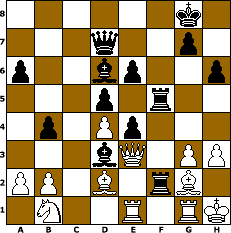In chess, zugzwang (German for "compulsion to move", IPA: tsuːk.tsvɑŋ occurs when one player is put at a disadvantage because he or she has to make a move — the player would like to pass and make no move, but the fact that the player must make one means being forced into a weaker position.
Normally in chess, having tempo is a good thing, since the player with the chance to move has greater power by being able to choose the "best" next move. Zugzwang typically occurs when all the moves available are "bad" moves, and better moves might be available if the player did not need to move at the current moment.

Zugzwang most often occurs in the endgame when the number of pieces, and so the number of possible moves, is reduced, and the exact move chosen is often more critical. The diagram on the right gives a simple example. Whoever is to move in this position loses the game — they must abandon their own pawn, thus allowing their opponent to capture it and go on to promote their own pawn. Because this is zugzwang no matter who is to move next, this is an example of mutual or reciprocal zugzwang.

In the diagram on the right is an example of when there is no mutual zugzwang. It doesn┤t matter whose turn it is, because white is able to force a win anyway. However, if the rules allowed for the black king to stand still, there would be a draw. (If it is white┤s turn, white wins in every case unless he moves the pawn forward or the king backward.)

The game Fritz Saemisch – Aaron Nimzowitsch, Copenhagen 1923, is sometimes called the "Immortal Zugzwang game" because the final position is widely accepted as being an extremely rare instance of zugzwang occurring in the middlegame. It ended with white resigning in this position:
White has a few pawn moves which do not lose material, but eventually he will have to move one of his pieces. If he plays Rc1 or Rd1 (see algebraic notation) then …Re2 traps white┤s Queen; Kh2 fails to …R5f3, also trapping the queen (white cannot play Bxf3 here because the bishop is pinned to the king); g4 runs into …R5f3 Bxf3 Rh2 mate. Other white moves lose material in more obvious ways. Whether this is true zugzwang is debatable however, because even if white could pass his move he would still lose after …R5f3 Bxf3 Rxf3, when his queen is again trapped.
The zugzwang theme is extensively used in chess compositions and endgame studies.
|
